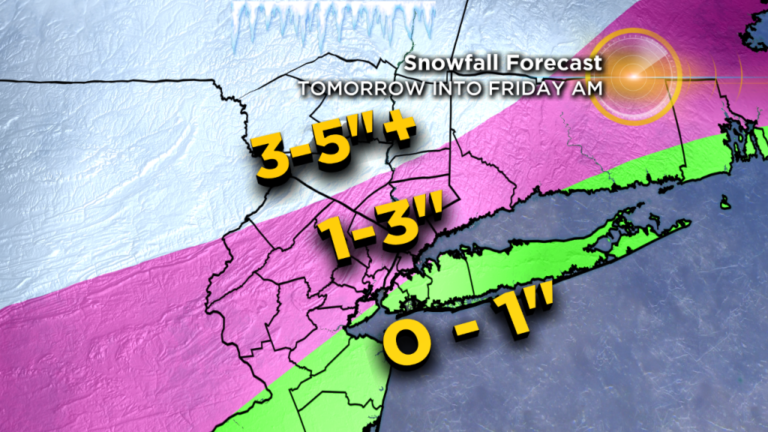The first snow of the season will be a nuisance for some before changing to rain, but the snow could accumulate several inches north and west of the city, especially in higher elevations.
Winter weather advisories have been issued for some parts of the Tri-State area ahead of the storm.
Temps drop into the 30s on Thursday, though the wind chill will make you want to keep your hands in your pockets most of the day. Much of THursday morning will stay cold, cloudy and dry before a wintry mix of precipitation arrives Thursday afternoon
The main area of concern is the evening commute, which officials expect to be sloppy and dangerous.
As far as accumulations, a slushy coating to an inch in New York City and the near the northern suburbs. Farther north and west, expect one to three inches of snow before the changeover, but more than 6 inches could fall in higher elevations.
Precipitation will change to plain rain at night in the city and along the coast, but expect wintry weather to continue north and west of the city for several hours into the evening before a changeover.
The New York City Emergency Management Department issued a travel advisory for Thursday, November 15. New Yorkers should prepare for slippery road conditions, and are advised to exercise caution when driving, walking, or biking.
“We are expecting the first snowfall of the season and we do not want you to be caught off guard,” said NYC Emergency Management Commissioner Joseph Esposito. “Take it slowly during the evening commute home and allow for extra travel time. The snow and rain can cause slippery road conditions during the evening rush.”
Department of Sanitation
· The New York City Department of Sanitation (DSNY) is readying 695 salt spreaders across the five boroughs. DSNY will activate PlowNYC and will dispatch plows if more than two inches of snow accumulates on roadways. DSNY has 275,000 tons of rock salt available for the winter season.
· Garbage/recycling collections are planned to be on normal schedules on Thursday.
· Alternate Side Parking is suspended Thursday to facilitate snow removal operations. Parking meters are in effect.
Safety Tips
· Drive slowly. Vehicles take longer to stop on snow and ice than on dry pavement.
· Four-wheel drive vehicles may make it easier to drive on snow-covered roads, but they stop less quickly than other vehicles.
· Use major streets or highways for travel whenever possible.
· Know your vehicle’s braking system. Vehicles with anti-lock brakes require a different braking technique than vehicles without anti-lock brakes in snowy conditions.
· If you are driving and begin to skid, ease your foot off the gas and steer in the direction you want the front of the car to go. Straighten the wheel when the car moves in the desired direction. If you have an anti-lock braking system (ABS), apply steady pressure to the brake pedal. Never pump the brakes on an ABS equipped vehicle.
· Try to keep your vehicle’s gas tank as full as possible.
· Pedestrians should exercise caution and avoid slippery surfaces; some ice may not be visible. Wear sturdy boots that provide traction to reduce slipping. Use handrails when using stairs.
· Seniors should take extra care outdoors to avoid slips and falls.
· Have heightened awareness of cars, particularly when approaching or crossing intersections.
(YWN World Headquarters – NYC)












One Response
השם ישמור אותנו